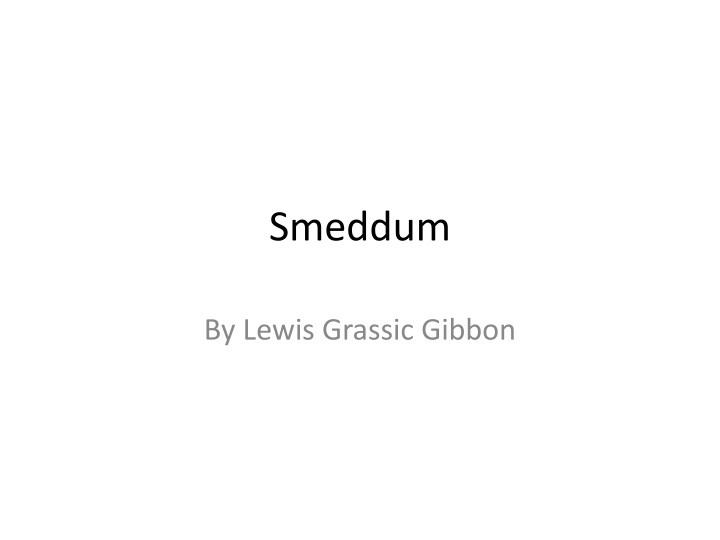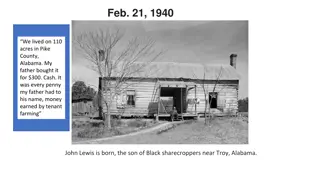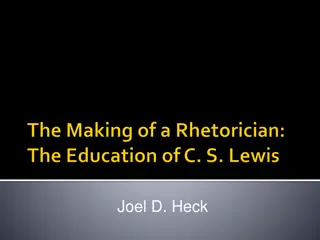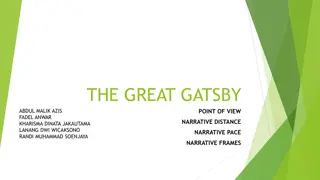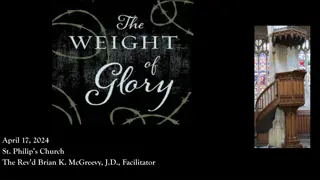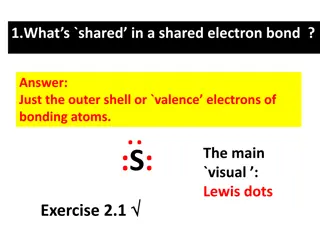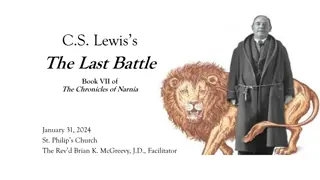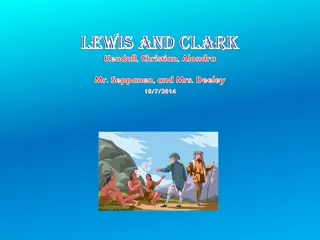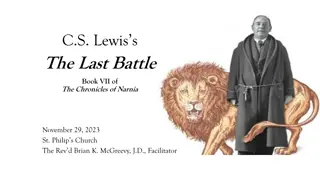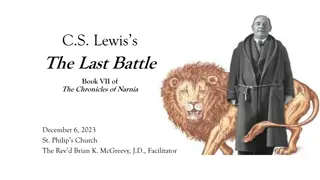Lewis Grassic Gibbon's Characters and Narrative Style
Lewis Grassic Gibbon, real name James Leslie Mitchell, was a notable Scottish writer known for his works such as "The Scots Quair." His narrative style, set in the Mearns region near Aberdeen, blends Scots and English, capturing the intimate and gossipy essence of the community. Explore Gibbon's heroines like Chris Guthrie and Meg Menzies, examining their evolution and significance in his stories. Dive into the rich imagery and language used by Gibbon, unlocking the layers of meaning within his works. Gain insights into his literary techniques and the local significance of his writing.
Download Presentation

Please find below an Image/Link to download the presentation.
The content on the website is provided AS IS for your information and personal use only. It may not be sold, licensed, or shared on other websites without obtaining consent from the author.If you encounter any issues during the download, it is possible that the publisher has removed the file from their server.
You are allowed to download the files provided on this website for personal or commercial use, subject to the condition that they are used lawfully. All files are the property of their respective owners.
The content on the website is provided AS IS for your information and personal use only. It may not be sold, licensed, or shared on other websites without obtaining consent from the author.
E N D
Presentation Transcript
Smeddum By Lewis Grassic Gibbon
Real name James Leslie Mitchell. Born 1901 Died 1935. Journalist- then joined army aged 19 and later the RAF. Full time writer from 1929 until his death. Major works- The Scots Quair (Sunset Song, Cloud Howe, Grey Granite). Other works: short stories and historical fiction, including Spartacus. Interests included left wing politics (founding member of the Aberdeen Soviet) and ancient history. About the author Lewis Grassic Gibbon Links with Arbuthnot, Montrose, Aberdeen
Setting and Narrative Style Grassic Gibbon s greatest work is set in the area where he grew up- The Mearns- Kincardineshire, near Aberdeen. In this story there are references to Bervie and Kinneff etc. He uses a blend of Scots and English Often he writes almost in the second person you thought His narrative style includes The speak of the Mearns - gossipy, intimate and showing all the prejudices of a community
Gibbons heroines Chris Guthrie- the girl who features in The Scots Quair. In the course of three books she goes from girl to middle aged woman Meg Menzies- the battle axe from Smeddum- a woman who breaks all the rules- and is a formidable parent
Learning Intentions Local significance (and a more accessible Gibbon text than Sunset Song )- The Montrose Renaissance Links with work on creative writing- character, theme and setting- you might use some of the techniques in your own piece of writing Language study- strong on imagery Potential text for exam
First reading Page 1 Who appears to be the narrator of this story? How many children did Meg and Will have? What did the locals think of her parenting skills? How can we tell she believes in justice? How can we tell she was less strict with her husband? Imagery Why does Gibbon compare Meg to a roan mare and Will to a weasel? (look at the next two slides for help) Look at the language used to describe the location and the weather- find examples of Scots language and explain why they are effective. a wind like a hail of knives from the hills - explain this image
Will Weasel Menzies Weasels are: Skinny Long Have sharp teeth Sneaky sly
Imagery The Clydesdale horse was the backbone of Scottish farming when Gibbon was a boy. These were workhorses- sturdy, capable- with a touch of mischief. The most sympathetic character in Animal Farm by George Orwell is a horse like this In your copy of the story, highlight all references where Meg is compared to a workhorse Look for other comparisons between characters from the story and animals
Explaining the image The two things being compared are __________ and _______________ Just as a _________________ is___________ so this character is_________________________ This is effective because you can imagine______________________________
Page 2- Meg the widow How does Meg react to the death of Will? How is the horse image continued here? Writing clues- what do we know so far about the Menzies relationship? Was it a happy one? Is it stated or implied? In farming communities, young school leavers were often fee d - put into service as farm labourers or domestic servants. How did Meg deal with her children if they ran away from their jobs? How did she deal with their employers? How can we tell there was local admiration for her as a crofter? (women might work on crofts, but few ran them by themselves) What can you tell about her sense of humour from the dialogue with the butcher?
Servants and the law Mistresses had to provide one month's notice, or wages in lieu of the notice period, but crucially, they were not legally compelled to provide a reference. Few servants could gain another job without this. Jean Rennie, a cook in service in the 1930s, told of being sacked in London without a reference, after having had the nerve to admit to her mistress that she was a writer. Her subsequent destitution, despite her skilled status and high demand for cooks, makes clear the obstacles to those who left an employer on bad terms. Servants and reformers continually demanded changes to the character system, to compel mistresses to give a written reference that was subject to the usual libel laws. It is clear that where workers can neither easily change jobs nor protest their conditions, a proportion will always suffer abuse. The nature of the private home as a workplace made abuse more likely because the tasks undertaken were intimate, often with no witnesses. Many servants resisted abuse, but the young, the migrant, and the orphaned were less able to do so. While the high demand for servants at various points in the twentieth century gave them some resistance to exploitation, the legal framework governing their employment remained punitive. Insubordination and 'defiance to proper orders' were legitimate legal grounds for instant dismissal. One female servant sued her mistress for her wages at Shoreditch County Court in 1913, after she was fired for 'answering saucily' and 'slapping things all over the place'. She lost her case; unable to prove her word against that of her mistress. The ability of mistresses to withhold references or give a bad 'character' was key to keeping the balance of power on the side of employers, making servants reluctant to give any cause for complaint. Even during times of relatively high-demand, servants were well aware that any lack of compliance could lead to the sack.
Funerals Mainly a male gathering- apart from the nearest relatives, women didn t go to the graveside The woman s job was to provide a meal of cold meats for the whole community- a funeral was one of the occasions for a get together
Social history- love, marriage and unplanned parenthood In previous centuries, common law marriages- co- habitation etc might be normal in rural communities where there was no church. You could formalise a relationship by hand fasting or jumping the broom . http://www.oneplusone.org.uk/content_topic/married -or-not/origins-of-the-myth-of-common-law-marriage/ By Victorian times, these customs were disappearing- and it was considered immoral to have children out of wedlock or to cohabit without being married. Victorian prudery lasted well into the 1970 s- especially in gossipy rural communities. Adultery and divorce were frowned on- and a banker from Segget would ruin his job prospects by running off with a free spirit.
Page 3- Jock How can we tell that Jock was vain? Quote A euphemism is a way of avoiding saying something that might be seen as a bit too harsh. Find two examples on page 3 of the story. How is the horse image continued on this page? Explain the animal image used to describe the minister. What would have happened to Ag had Meg not got on Jock s case? How does Meg teach Jock a lesson that day- and afterwards? Return to this part of the story after you look at the ending
Conventions It was as well there was a thing called marriage- folks held together and couldn t get apart - what do the locals think of Meg and her husband? In what way is their relationship unusual? nothing like a wedding for redding things up - look at Meg s reaction when the minister says this to her. What is unusual about it? Revisit your answer when you finish work on the story. you d to marry or burn, so I married you right quick - what does Meg mean? (marry or burn is a quote from St Augustine) Look for all the references in the story to marriage, and why it is believed to be a good thing.
As we go through the Scandals parts of the story, think of how Meg is looking out for her children. To what extent does she treat all her children the same? Quote How can we tell that she knows her family s strengths and weaknesses? Quote Parenthood What makes a person a good parent? In your groups, brainstorm the things a good parent does. Share with the group and with the class
Scandals- page 4 Jeannie Unplanned pregnancies Find references to these in the Menzies family Quote Show how Meg deals with these situations. Thieving Find a reference to this in the Menzies family Quote Show how Meg deals with it. Do you agree with how she did this?
Kathleen Meg stood and stared after the slip of a quean, you d have thought her half-angry, half near to laughing, as she watched that figure, so slender and trig, with its shoulders square-set, slide down the hill on the wheeling bike, swallows were dipping and flying by Kinneff, she looked light and free as a swallow herself, the quean as she biked away from her home, she turned at the bend and waved and whistled, she whistled like a loon and as loud, did Kath. What do you notice about the imagery used to describe Kathy? The two things being compared are a girl and a bird in flight Just as a swallow in flight is .. so Kathy is .. Unlike her siblings, Kathy is compared not to a farm animal but to a swallow- this suggests that She is also compared to a boy, which suggests that
Scandals pages 4-5 Kathleen Kath Menzies Look at how Kath speaks to her mother. Is she afraid of her, or does she treat her as an equal? How can you tell? How is this different from her older siblings? How would Meg have reacted to this from Jeannie or Jock? How does her mum feel about her as she watches her leave home? What did Kath do to make the speak of the Mearns have a field day? What scandal did she create? Return of the prodigal How does Kath continue, on her return to make the locals gossip about her? What does her older brother think? (look at the bottom of page 5) How can we tell he has strong feelings about this?
Page 6 John Robb How had John met Kathy? How can we tell that he is a romantic?(quote) How can we tell he isn t intimidated by Meg? (quote) How is this different from her treatment of her other sons in law? Meg and Kathy What were the gossips expecting to see happen between Meg and her daughter?(quote) What actually happened? What request does Kath make of her mother?(quote)
The denouement -page 7 What is revealed about Meg Consider how she was portrayed at the start of the story? How can we tell she was a good mother? How can we tell that she only gave respect where it was due and was afraid of nothing? What was the real relationship between her and Will? Was she right to treat him like this? What decision does Kathy make? Why would this have been unusual for the 1930 s? How do her siblings react? How is animal imagery used here? How does Meg support her daughter? How can we tell that this child is special to Meg? Why might this be the case?
So- what is Smeddum? If you had to write a dictionary definition of the word, what would it be? By the end of the story- how does the reader feel about Kath and Meg? One critic has said that Meg shatters the archetypal mould of conventional womanhood and goes forth in fear of neither God nor man Do you agree?
Try an essay question Choose a short story which has at its heart a memorable female character. Discuss the techniques used by the writer to bring this character to life. Or choose a story which deals with family tensions and conflicts. Paying close reference to the text, examine how the writer made these tensions memorable for the reader.
